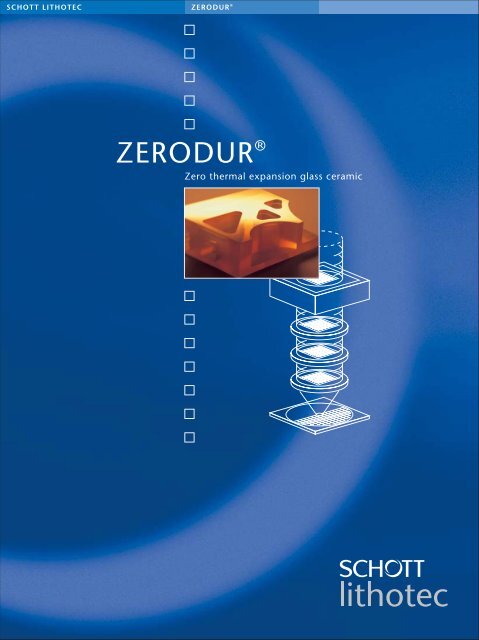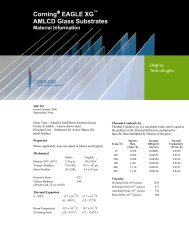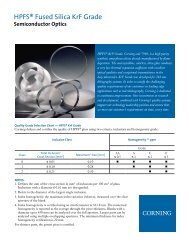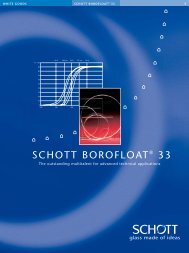ZERODUR® - Mark Optics Inc.
ZERODUR® - Mark Optics Inc.
ZERODUR® - Mark Optics Inc.
Create successful ePaper yourself
Turn your PDF publications into a flip-book with our unique Google optimized e-Paper software.
SCHOTT LITHOTEC<br />
ZERODUR ®<br />
ZERODUR ®<br />
Zero thermal expansion glass ceramic
Schott Lithotec<br />
ZERODUR ®<br />
For many years ZERODUR ® zero thermal<br />
expansion material has provided for reliable<br />
designs in precision optical applications.<br />
The homogeneity of the material properties<br />
of ZERODUR ® enables opto-mechanical<br />
engineering solutions with long-term<br />
mechanical and thermal stability. The easyto-achieve<br />
optical figure and improved<br />
microroughness have contributed to the<br />
success of this material.<br />
ZERODUR ® is widely used as a mirror<br />
substrate material and for precision frames<br />
in current state-of-the-art microlithography<br />
equipment.<br />
Specific structuring of the material allows<br />
superior stability of designs in ambitious<br />
dynamic environments, such as stages in<br />
wafer steppers and scanners.<br />
With its ability to match zero thermal<br />
expansion very closely, ZERODUR ® is<br />
one of the prime material candidates for<br />
substrates in lithography applications at<br />
wavelengths around 13 nm (EUVL).<br />
Applications support from Schott Lithotec<br />
is available for material properties and<br />
specific customers designs of structured<br />
components.<br />
Reticle stage<br />
made of ZERODUR ®<br />
8 inch Wafer Stage<br />
made of ZERODUR ®
Thermal properties<br />
Mean coefficient of<br />
linear thermal expansion<br />
The most important and significant properties of the optical glass ceramic<br />
ZERODUR ® are the extremely small coefficient of linear thermal expansion as<br />
well as the homogeneity of this coefficient throughout the entire piece.<br />
Individual pieces of ZERODUR ® (discs, plates, rods) can be supplied with a mean<br />
coefficient of linear thermal expansion α in the temperature range 0°C to 50°C<br />
in three expansion classes as follows:<br />
Material up to Expansion class 2 will be supplied as a standard. Closer tolerances<br />
will be supplied upon request.<br />
The graph below illustrates the typical coefficient of linear thermal expansion α.<br />
ZERODUR ® exhibits a very slight linear expansion over the entire temperature<br />
range. It is especially low in the room temperature range.<br />
α [10 -6 /K]<br />
0,6<br />
0,4<br />
0,2<br />
Expansion class 0 0± 0.02·10 -6 /K<br />
Expansion class 1 0± 0.05·10 -6 /K<br />
Expansion class 2 0± 0.10·10 -6 /K<br />
0,0<br />
-0,2<br />
-0,4<br />
-0,6<br />
-0,8<br />
0 °C 100 °C<br />
0 100 200 300 400 500 600 700 800 900<br />
ZERODUR ® M If even higher thermal expansion quality is required and cooling rates other than<br />
0.1K/min (or the initial cooling rate) can not be avoided in the critical temperature<br />
region during processing or use of ZERODUR ® , we recommend considering the<br />
use of ZERODUR ® M as a material variation of ZERODUR ® .<br />
Temperature [K]
Shapes and dimensional tolerances<br />
Mechanical Properties<br />
The table shows the typical and improved tolerances for disks, rectangular blocks,<br />
rods and complex shapes. Improved tolerances can be provided for an additional<br />
charge.<br />
Even tighter tolerances can be provided upon special request.<br />
Shape Criterion Dimensions Typical<br />
tolerance<br />
Improved<br />
tolerance<br />
Disks Diameter < 500 mm ± 0.3 mm ± 0.1 mm<br />
Diameter < 1000 mm ± 0.4 mm ± 0.2 mm<br />
Diameter < 4200 mm ± 0.5 mm ± 0.3 mm<br />
Thickness – ± 0.3 mm ± 0.05 mm<br />
Profile tolerance<br />
zone of radius<br />
< ø 2000 mm ≤ 0.2 mm ≤ 0.1 mm<br />
Profile tolerance<br />
zone of radius<br />
> ø 2000 mm ≤ 0.3 mm ≤ 0.2 mm<br />
Rods Diameter L ≤ 500 mm and/<br />
or ø ≤ 80 mm<br />
± 0.3 mm ± 0.01 mm<br />
Diameter L > 500 mm and/<br />
or ø > 80 mm<br />
± 0.3 mm –<br />
Length ø ≤ 80 mm ± 0.3 mm ± 0.2 mm<br />
Length ø > 80 mm ± 0.4 mm ± 0.3 mm<br />
Plates Length/thickness – ± 0.3 mm ± 0.05 mm<br />
Flatness < 500 mm ≤ 0.4 mm ≤ 0.05 mm<br />
Flatness ≥ 500 mm ≤ 0.4 mm ≤ 0.2 mm<br />
Polishing/ Detailed specification required<br />
Lightweighting<br />
Criterion<br />
Young’s modulus (at 20 °C, GPa) – mean value 90,3<br />
Poisson’s ratio µ 0,243<br />
Knoop hardness HK 0,1/20 acc. to ISO 9385 620<br />
Density ρ (g/cm3 ) 2,53
Internal quality<br />
<strong>Inc</strong>lusions<br />
Striae<br />
Bulk stress<br />
The internal quality of ZERODUR ® is essentially determined through<br />
<strong>Inc</strong>lusions<br />
Striae<br />
Bulk stress<br />
As a rule inclusions are mainly bubbles and to some extent individual particles.<br />
<strong>Inc</strong>lusions have no effect on the function of ZERODUR ® as a substrate material for<br />
surfaces of the highest quality in so far as they lie completely within the volume.<br />
<strong>Inc</strong>lusions in ZERODUR ® are distinguished by the designations “Standard“ and<br />
”Special“ and also draw on the <strong>Inc</strong>lusion Classes 3 to 0 which apply to optical glass.<br />
StandardSpecialClass 3Class 2Class 1Class<br />
0<br />
Maximum diameter<br />
of individual inclusions<br />
in mm for different<br />
diameters or diagonals<br />
of the ZERODUR ® part<br />
In the critical volume<br />
< 500 mm<br />
In the uncritical volume<br />
1.4 1.2 1.0 0.8 0.6 0.4<br />
< 500 mm 3.0 2.0 1.5 1.0 0.8 0.6<br />
Striae are locally very limited transparent regions with composition differing only<br />
slightly from the basic material.<br />
The striae values listed below are maximum values for five quality levels up to a<br />
given diameter or diagonal of ZERODUR ® parts.<br />
Stress birefringence caused<br />
by striae [nm/stria] for parts<br />
with diameters or diagonals<br />
Standard Special Class 3 Class 2 Class 1<br />
< 500 mm 60 45 30 5 –<br />
All ZERODUR ® parts are subjected to precision optical annealing in order to achieve<br />
permanent bulk stress, which is low and symmetrically distributed.<br />
Bulk stress causes optical birefringence. The stress birefringence is measured as a<br />
path difference.<br />
Bulk stress birefringence<br />
[nm/cm] for parts with<br />
diameters or diagonals<br />
Standard Special<br />
< 500 mm 6 4
ZERODUR ® Bonded Components<br />
General Low Temperature Bonding (LTB)<br />
information<br />
Narrative adapted from telecom write-up previously prepared for OFC.<br />
Bonded ZERODUR ® components are mechanically robust and can be<br />
machined, chemically durable in traditional grinding and polishing<br />
environments, and are thermally stable in environments ranging from<br />
room temperature to at least 600ºC.<br />
Visual Appearance and<br />
Bond Thickness<br />
Bonds formed between ZERODUR ®<br />
material are optically transparent and<br />
can be tailored to fill gaps of defined<br />
thickness. Bond thicknesses can be<br />
varied by modifying processing conditions<br />
and part attributes. Typical<br />
FIB/SEM results are shown at the right<br />
for thick bonds as well as thin bonds.<br />
Shapes and Dimensional Information<br />
LTB can be applied to solid parts as well as light-weighted (ribbed)<br />
structures.<br />
Solid ZERODUR ® components have been fabricated up to 2 inches in<br />
diameter with high strength suitable to subsequent post-processing<br />
(core drilling, blocking, grinding and polishing).<br />
Lightweighted structures have been fabricated from ZERODUR ® up<br />
to sizes of 265 mm diameter with rib structures as thin as 2 mm. An<br />
example of a light-weighted ZERODUR ® sample is shown at the left.
Transmission<br />
Bonds are transparent from 160 nm<br />
to 2 µm (see figures) and have a<br />
nominal refractive index (25°C) of<br />
1.47.<br />
Mechanical Strength<br />
Bonded ZERODUR ® components are<br />
mechanically robust, showing MOR’s<br />
comparable to that of monolithic<br />
ZERODUR ® as determined from 4 pt<br />
bend flexure testing.<br />
[T %]<br />
100<br />
90<br />
80<br />
70<br />
60<br />
50<br />
40<br />
30<br />
20<br />
10<br />
Bonded (5mm)<br />
Mono 1 (5mm)<br />
Mono 2 (5mm)<br />
0<br />
160<br />
[T %]<br />
170 180 190 200<br />
Lambda/nm<br />
100<br />
90<br />
80<br />
70<br />
60<br />
50<br />
40<br />
30<br />
20<br />
10<br />
Bonded ZERODUR ®<br />
Monolithic ZERODUR ®<br />
0<br />
0 500 1000 1500 2000 2500<br />
Wavelength (nm)<br />
Bonded components contain minimal residual stress (3nm/cm).<br />
Flexure Strength (MPa)<br />
70<br />
60<br />
50<br />
40<br />
30<br />
20<br />
10<br />
0<br />
52 32 24 35 43<br />
Polished Surfaces<br />
RT Cure<br />
Polished Surfaces<br />
Std. Cure<br />
Ground Surfaces<br />
RT Cure<br />
Measured on core drilled, fine ground specimens<br />
Ground Surfaces<br />
Std. Cure<br />
Monolithic
Thermal Shock Resistance<br />
Bonded samples were submerged in liquid nitrogen for nearly<br />
3 minutes. In all cases, there was no significant change in measured<br />
bond strength after thermal schock.<br />
Flexure Strength (MPa)<br />
70<br />
60<br />
50<br />
40<br />
30<br />
20<br />
10<br />
0<br />
52 50 32 40 24<br />
Polished<br />
RT Cure<br />
Polished<br />
RT Cure<br />
Polished<br />
Std. Cure<br />
Polished<br />
Std. Cure<br />
Low Thermal Expansion<br />
Ground<br />
RT Cure<br />
Not Thermally Shocked<br />
N2 Thermally<br />
20 35 31<br />
Ground<br />
RT Cure<br />
Ground<br />
Std. Cure<br />
Ground<br />
Std. Cure<br />
Bonded ZERODUR ® components exhibit CTE performance<br />
(RT-300 ºC) commensurate to monolithic ZERODUR ® for bonding<br />
perpendicular to bonding axis.<br />
Average CTE from 0–50°C<br />
0<br />
–10<br />
–20<br />
–30<br />
–40<br />
–50<br />
–60<br />
Cure Temperature<br />
CTE Rod #2<br />
CTE Rod #1<br />
20 40 60 80 100 120 140
Environmental Stability<br />
All samples made with polished<br />
ZERODUR ® surfaces, regardless of<br />
curing temperature, show no strength<br />
degradation after a 1-week treatment<br />
under 85/85 conditions.<br />
Samples made using fine ground surfaces,<br />
regardless of curing temperature,<br />
20<br />
show a significant strength degrada-<br />
10<br />
tion after the same 85/85 treatment. 0<br />
Vacuum Compatibility<br />
Vacuum levels attained:<br />
Flexure Strength (MPa)<br />
70<br />
60<br />
50<br />
40<br />
30<br />
42 45 27 38 24<br />
Polished<br />
RT Cure<br />
Polished<br />
RT Cure<br />
10 –12 mbar/liter/sec, meaning 1 liter of He leaking per second at<br />
10 –12 mbar pressure, equivalent to ~3 x 107 atoms/sec (ultra-high<br />
vacuum range)<br />
■ Leak rate below current detection limit; lower than that typically<br />
specified by manufacturers of UHV valves<br />
■ Same results on both heat-treated and non-heat treated samples;<br />
no signs of degassing in either sample, though samples had been<br />
bonded ~1 month prior to test<br />
■ 10 –9 torr also demonstrated at Honeywell on non-λ/3 parts: both<br />
cured and non-cured<br />
Polished<br />
Std. Cure<br />
Polished<br />
Std. Cure<br />
Ground<br />
RT Cure<br />
Un-treated<br />
After 85/85 for 1 week<br />
10 40 17<br />
Ground<br />
RT Cure<br />
Ground<br />
Std. Cure<br />
Ground<br />
Std. Cure
Schott Lithotec AG<br />
Sales Office<br />
Wilh.-Th.-Roemheld-Strasse 32<br />
55130 Mainz<br />
Germany<br />
Phone: +49(0)6131/8 01 26 - 12<br />
Fax: +49(0)6131/8 01 26 - 27<br />
E-mail: sales.lithotec@schott.com<br />
www.schott.com/lithotec<br />
10152 e ba/kn/wo Printed in Germany








